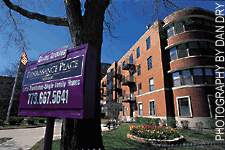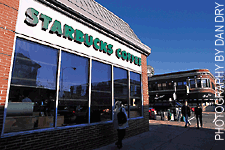What
has the change meant for real-estate prices? In the
1980s, people bought occupied houses in North Kenwood for $30,000,
"half that for boarded-up houses," recalls Winston Kennedy, a
South Side real-estate agent for 30 years. "Now home buyers are
paying $200,000 and $300,000," says Kennedy. "Very pricey."
The
same process has been gaining speed south of Hyde Park in Woodlawn,
territory ruled in the mid-1970s by the Blackstone Rangers street
gang. Developers such as Alison Davis Jr., the son of a distinguished
Chicago faculty member, have joined with community leaders like
the Reverend Leon Finney, pastor of Christ Apostolic Church and
director of the Woodlawn Community Development Organization, and
Bishop Arthur Brazier of the Apostolic Church of God (at 15,500,
the largest congregation in the city of Chicago), who's also chairman
of the Woodlawn Preservation and Investment Corporation and of
the Fund for Community Redevelopment and Revitalization. Together,
these groups have spearheaded the construction of several waves
of new middle-class houses, slowly working their way south from
61st Street along Kenwood and Ellis and Blackstone. Construction
has also begun for another 152 units along 63rd Street.
 |
| Renaissance
Place homes
are going fast. |
"In
the '60s and '70s, Woodlawn looked like a pyromaniac lit all the
buildings there," Finney told the Chicago Tribune in 1999.
"It was
far from the community of choice, [but] we had to start somewhere."
Now the neighborhood is in transition, says Brazier, "from a community
based on poverty to a moderate and middle-income neighborhood.
And that brings economic development, improved schools, and a
reduction in crime." Fortunately, he adds, the transition did
not force out current residents. Poverty
and
perceptions of crime had already chased out many of those who
could afford to leave--hence the pyromaniacal appearance--and
new health, welfare-to-work, and community policy programs, along
with improved city services, have regained the loyalties of low-
and moderate-income families. "This is no longer a place that
people run from," says Brazier.
One
gauge of the influx of buyers into the South Side can be seen
in the near saturation of the Hyde Park real-estate market. Dyrud
only has a few things to show Chase because somebody's buying
up everything else.
"Across
the board," agrees Hyde Parker Robert C. Sullivan, AM'77, MBA'86,
an agent for Urban Search, "from the 12,000-square-foot Kenwood
mansions to the one-bedroom condos, everything is moving pretty
quickly." The neighborhood was long a forgotten area, he recalls.
But as prices and density and traffic to the north have mushroomed,
this southern alternative--with real neighborhoods, front lawns
and back yards, museums and schools, and an easy commute--looks
better and better. "Prices used to be about half as high as Lincoln
Park," says Sullivan, "but that gap is rapidly closing."
Several
upscale developers, many of them new to South Side real estate,
have been eager to ease the crunch. "There's new housing all over
the place," declares Webber, obviously excited about the prospect,
"more than $150 million in private residential housing, almost
600 units, built here in the last decade. That's the Hyde Park
people live in now, a whir of cranes. These are good times for
Hyde Park."
 |
| Starbucks
Coffee in
Harper Court sells latte. |
A
habitual list maker, Webber can tick off the recent housing starts,
a daunting process with 16 residential developments, some in multiple
stages, breaking ground since 1989. The largest, begun in 1998,
is Renaissance Place, where the Chicago Osteopathic Hospital once
stood, with more than 200 loft condominiums in the former hospital
complex, plus 28 new town houses and 16 stand-alone homes. Cornell
Square, begun in two phases between 1995 and 1998, includes 81
town houses and single-family homes. Forty-four new homes have
been built and sold at 5350 South Shore Drive, the former site
of Temple Sinai.
The
list goes on and the prices go up. The Renaissance Place condos
were offered at $98,000 and up. Larger town homes on South Shore
Drive hit the market for between $250,000 and $500,000 and sold
immediately. One of them, with a lake view, resold two years later,
Dyrud informs Chase, for more than $700,000. Seven luxury town
homes facing the lake north of 51st Street hit the market at $525,000.
Who
is buying these things? With 12,000 faculty and staff, the largest
employer on the South Side, and 10,000 students, the U of C and
its Hospitals still dominate the area. "We have, by far, the highest
percentage of faculty, just over 62 percent, living in the neighborhood
of any university in a large city," says Webber, contrasting Hyde
Park with the Cambridge neighborhood around Harvard, home to only
32.5 percent of that institution's faculty. "But what's extraordinary,"
he adds, "is that the new housing is not predominantly being bought
by University faculty or staff. It's people who work downtown
and want an easy commute, people with children, young professionals
who have figured out that this is a much better deal economically
than the North Side."
But
"this is not Lincoln Park," proclaims Webber, getting wound
up. "One, Hyde Park is a lot more diverse. Hyde Park has roughly
equal numbers of whites and African Americans, with a significant
Asian population as well. Two, this is a family neighborhood.
Three, this may not be an inexpensive neighborhood but it is still
an affordable one." Fourth, he notes, there is a range of housing,
apartments, condos, houses--large and small, vintage and new.
Real-estate prices are going up as much as 10 percent a year but
there are still 2,039 subsidized housing units in Hyde Park, about
the same as ten years ago. "They're so well managed," adds Webber,
"That not many people know that."
 |
Although
established residents appreciate any increase, the rising cost
of housing in Hyde Park can present a problem for incoming junior
faculty, says Richard Saller, dean of the Social Sciences, and
indeed the University is renovating and subsidizing some of its
rental housing for junior faculty. At the same time, Saller says,
the softer market around the boundaries of Hyde Park makes the
problem less severe for Chicago than for many urban universities.
"Given
a choice between a rundown neighborhood with low property prices
and an improving neighborhood with inflating prices," adds Saller,
"I'll take the latter. I think that it's a good thing that we
are beginning to get away from the 'fortress Hyde Park' mentality
and to see the city with its varied neighborhoods as an asset."
As
the neighborhood becomes more attractive to more people, rents
have also increased, but they have not kept pace with purchase
prices. Students are somewhat protected from this increase by
the option of University housing (in addition to the undergraduate
dorms there are 1,130 student housing units in the neighborhood),
where increases have been held to the 3- to 4-percent range.
Despite
mild gentrification, Hyde Park-Kenwood has retained its famed
ethnic and cultural diversity. Since 1960, the University community
has remained racially balanced; about 50 percent of the 41,000
residents are African American, 40 percent white, and 10 percent
Asian, primarily Chinese. The neighborhood's average income has
climbed from 10 percent above the city of Chicago average in 1970
to 40 percent higher by 1990, and about 65 percent higher in 1998.
The average Hyde Parker now earns about $32,500, slightly more
than the per capita income of Evanston or Oak Park residents.
This
diversity is also apparent in the range of local schools. A brochure,
"Raising Our City Kids," from Alderman Preckwinkle's office lists
20 neighborhood schools, including the University's Laboratory
Schools; Kenwood Academy, cited by U.S. News and World Report
as one of the nation's outstanding high schools; the Philip Murray
Language Academy, which stresses early exposure to foreign languages;
and 17 other public, private, and parochial schools. In addition
to providing safety suggestions for city kids, the brochure also
lists the types of programs that flourish in suburbia, from after-school
arts programs to AYSO soccer.




![]()


